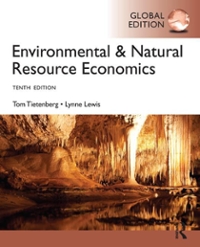Question
In this question we will combine a very simplified model of an externality that has long-lasting impacts with the model of discounted utility that we
In this question we will combine a very simplified model of an externality that has long-lasting impacts with the model of discounted utility that we learned in our game theory topic. Consider a hypothetical environmental externality: produced as the byproduct of industrial activity, each unit of emission of a pollutant that is emitted once, today, causes $10 of external harm to society each and every year, starting immediately, forever. Let's say that policymakers apply a discount factor of ? ? (0, 1) to future gains and losses, in an analog of the discounted utility model except for cash payoffs rather than utilities.
What would the socially efficient Pigouvian tax on the emission of this pollutant be if we applied a discount factor of (i) ? = 0.5, (ii) ? = 0.9, and (iii) ? = 0.99? Give an intuitive explanation of how to interpret the parameter ? in this context, and explain precisely but in simple terms what the goal and effect of the Pigouvian tax would be.

Step by Step Solution
There are 3 Steps involved in it
Step: 1

Get Instant Access to Expert-Tailored Solutions
See step-by-step solutions with expert insights and AI powered tools for academic success
Step: 2

Step: 3

Ace Your Homework with AI
Get the answers you need in no time with our AI-driven, step-by-step assistance
Get Started


